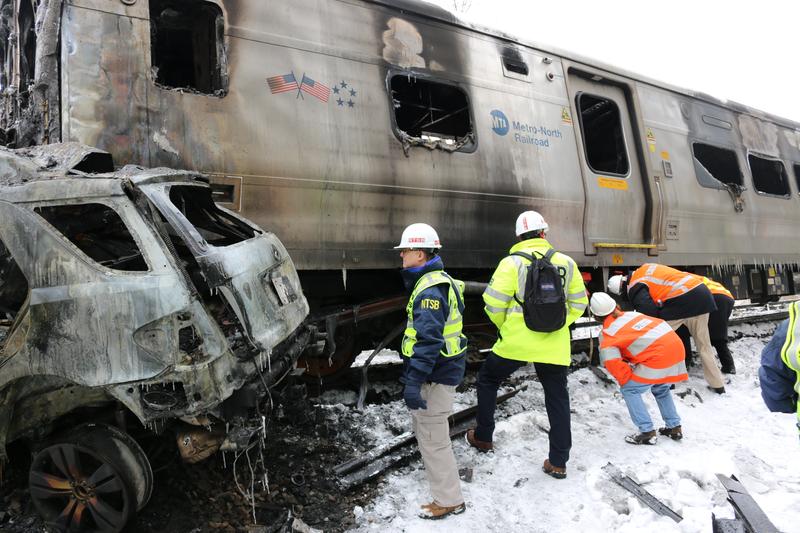 Transportation Nation
Transportation Nation
Metro-North Investigation to Ask: Why Was She There?

Investigators looking at Tuesday's deadly Metro North crash know the questions they want to ask — but none of the answers.
The collision, which occurred in the village of Valhalla in Westchester County around 6:30 p.m., killed six people: five train passengers and the driver of an SUV that had stopped on the tracks while driving across them. At least 15 others were seriously injured.
At a briefing late Wednesday afternoon, a member of the National Transportation Safety Board, Robert Sumwalt, said the agency would seek to answer two major questions.
"The big question everyone wants to know is: Why was this vehicle in the crossing?" he said.
After spending seven hours at the site, Sumwalt could shed no light on that point, although one eyewitness described seeing the driver of the car exit the vehicle and look at the crossing gate arm, which was reportedly on the rear end of her vehicle.
An even more important question, according to Sumwalt, is why the crash killed so many people. Collisions between trains and vehicles frequently happen in the United States because of the preponderance of places where railroad tracks cross roads. But Sumwalt said usually those collisions do not endanger the occupants of the train.
"We intend to find out what makes this accident different, that caused it to be fatal to five people on the train," he said. "That's going to be the heart of it."
One possible reason: the electrified third rail, which provides power to the train, broke off during the collision. Sumwalt said the steel entered the chassis of the SUV behind the driver's seat, then continued into the first car of the Metro-North train, where it began breaking off into 80-foot sections.
"At least one piece penetrated the second car," said Sumwalt.
He also said the fuel in the SUV may have acted as an accelerant, creating a massive fire that burned out the interior of the rail car.
The bodies of at least some of the victims were so badly burnt that officials have been using dental records to identify them. Several people remain hospitalized. Dr. Joseph Turkowski, the head of the burn unit at Westchester County Medical Center, said victims suffered from lacerations, contusions, open fractures, smoke inhalation, burns and other injuries.
The driver of the vehicle was identified as 49-year-old Ellen Brody, a mother of three. She worked at a jewelry store in Chappaqua, north of Valhalla, and was on her way home when she crossed the railroad tracks traveling east on Commerce Street, according to friends and family.
A view of the intersection where Ellen Brody crossed Metro-North tracks Tuesday evening. (Google Street View)
Paul Feiner, the town supervisor in Greenburgh, where Brody lived, says she was a "role model for kindness" and not the kind of person who was careless or risky when it came to her safety or others.
Another victim was Walter Liedtke, a curator at the Metropolitan Museum of Art who specialized in Dutch and Flemish paintings.
"He organized dozens of major exhibitions that brought the works of Rembrandt, Vermeer, Hals and many other great artists to millions of our visitors," a statement from the museum said. "He will long be remembered for his vast knowledge, his wit, and a passion for art that inspired all who came in contact with him.”
The train was going under the speed limit, according to New York Sen. Charles Schumer. He said preliminary information indicated the train was going 58 mph. Metro-North said the speed limit on that stretch of track is 60 mph. The NTSB said it would not release details about the train's speed until Thursday.
Sumwalt said federal investigators will be on site for five to seven days, collecting "perishable" information — "the information that can go away with the passage of time."
This is not the first deadly car-train collision at that crossing site. In 1984, a man behind the wheel of a van was struck and killed by a train.